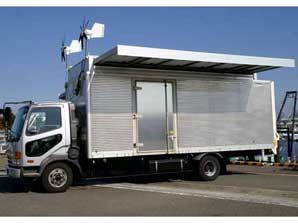Web Japan > Trends in Japan > Sci-tech > Water Purification on the Go
Water Purification on the Go
Mobile Desalination Unit Offers Hope to Disaster-Hit Regions

The truck-loaded Courier Water.
(C)Organization for the Development of Private Participation in Public Projects

The truck-loaded Courier Water.
(C)Organization for the Development of Private Participation in Public Projects
Water shortages are a growing problem around the world, especially in developing countries. Desalination, or turning seawater into potable water, is one way of increasing water supplies, but desalination plants require vast amounts of energy and infrastructure. Now a Japanese team has developed Courier Water, a mobile desalination unit that has tremendous potential for helping people in areas affected by water shortages or natural disasters. The unit's defining feature is its mobility. With its compact design, Courier Water can be installed on a four-ton truck, allowing it to travel far and wide.
Using Renewable EnergyThe desalination of seawater is practiced across the world. This is commonly done by separating water from salt and other impurities using reverse osmosis membranes, which let through small water molecules but not ions and larger molecules. The problem with conventional systems is that it takes a great deal of energy to generate the high pressure needed to push the water through the membranes. Making the water pure enough to drink calls for fine membranes, and the finer the membrane, the higher the pressure must be to allow water molecules to pass through. The need for so much energy has made seawater desalination incompatible with renewable energy systems, whose power generation capabilities tend to be limited.
Courier Water, a truck-loaded system recently developed jointly by the Organization for the Development of Private Participation in Public Projects and several private enterprises, overcomes this problem. It incorporates a pump that produces pressure of about 6 MPa, enough to desalinize seawater, with only a small amount of energy. On the roof are solar panels that spread to over twice the truck's width, and two wind turbines. In fair weather the electricity generated from the sun and wind can provide nearly 100% of the power needed, enabling the system to operate even in areas with an inadequate power supply, such as remote or disaster-affected communities.

Mobile seawater purification and drinking water supply system.
(C)Organization for the Development of Private Participation in Public Projects
A Safe and Natural CoagulantCourier Water employs a safe coagulant made from natural substances including polyglutamic acid and calcium. Polyglutamic acid is an amino acid polymer widely known to be responsible for the threadlike goo of natto, the traditional Japanese food otherwise known as fermented soybeans. The coagulant is used to clot particles of impurities in the water prior to filtration by reverse osmosis, simplifying the filtration process. Coagulation significantly improves water quality, as well as reducing the strain on the reverse osmosis membrane.
In addition to its safety and efficiency, Courier Water's coagulant is distinct in that it has little effect on the pH level of the water. This eliminates the need to adjust the pH of the water using sodium hydroxide or other caustic agents, which cannot be handled without a special license. The coagulant also removes any heavy metals contained in the water.
The truck-loaded Courier Water is capable of producing 7.2 tons of drinking water in a day, enough for 3,600 people, assuming that a person drinks 2 liters per day. A container-type system has also been developed. While not mobile, it is capable of purifying several times more water than its mobile counterpart and will be transported to its destination mainly by ship. The two water purification systems are expected to be used both domestically, such as for disaster relief and in remote islands, and around the world, including in arid regions and areas without running water. The developers aim to begin supplying the systems by the end of 2009. (October 2009)
- Does Japan's Water Taste Good? (May 9, 2003)
- World Water Forum (March 14, 2003)
